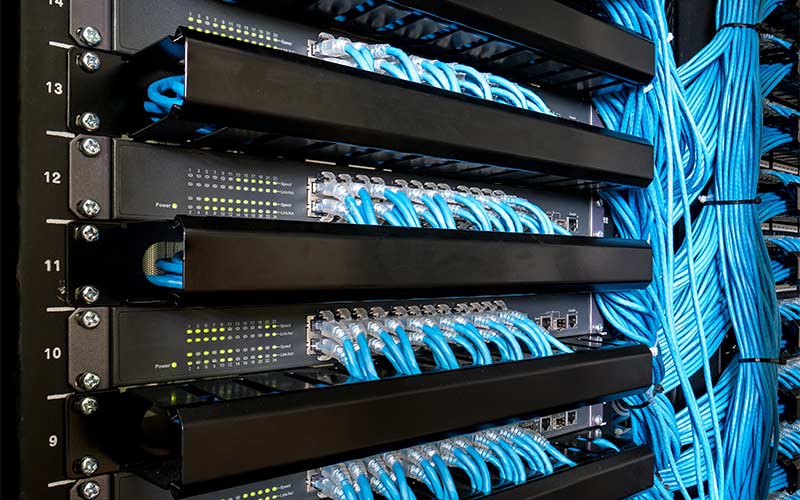What are IP Addresses? IP addresses are fundamental to the digital infrastructure of any business…

The development of Ethernet technology has come a long way since its introduction in the 1970s.
Over the years, Ethernet has evolved to meet the growing demands for faster and more reliable network connections, with the size of network ports increasing in accordance with those demands. In this blog post, we’ll take a look at the historical evolution of network port sizes, beginning with 10BASE-T and ending with the current state-of-the-art: 100 Gigabit Ethernet.
10BASE-T (10 Mbps)
10BASE-T, which stands for 10 megabits per second (Mbps) Baseband Transmission over Twisted Pair cable, is an Ethernet technology that was introduced in 1990 and became widely adopted as one of the first Ethernet standards. Providing a data transfer rate of 10 Mbps over twisted-pair cable, 10BASE-T was designed to support the growing demand for faster network connections. At the time, the previous Ethernet standards of 10BASE5 (introduced in 1980 and named “thicknet” for its thick coaxial cable) and 10BASE2 (introduced in 1985 and named “thinnet” for its thinner, more pliable cable) were limited in their ability to support the increasing number of users and devices on local area networks (LANs). 10BASE-T was designed to address this growing demand by providing a more reliable connection over twisted-pair cable, which was easier to install and maintain than its thicknet and thinnet predecessors.
Fast Ethernet (100 Mbps)
100BASE-TX was introduced in 1995 as the first “Fast Ethernet” standard, a term used to describe a set of Ethernet standards that provide faster data transfer rates than the original Ethernet standard. At 100 Mbps, Fast Ethernet offered data transfer rates at ten times the 10 Mbps throughput available with its 10BASE predecessors. Fast Ethernet was designed to support the growing demand for even faster network connections and was highly impactful to a variety of applications, including multimedia and the Internet. Designed to address these demands by providing ten times the throughput, 100BASE-TX used the same twisted-pair cables (e.g. Category 5 or higher) already being widely used in LANs and supported the same 100 meter distances as 10BASE-T without the need for signal boosters.
Gigabit Ethernet (1 Gbps)
The next major milestone in the evolution of Ethernet was the introduction of Gigabit Ethernet (GbE) in 1999. GbE provided a data transfer rate of 1 gigabit per second (Gbps), keeping again with the factor of ten boost that Fast Ethernet offered four years prior. GbE was designed to support high-bandwidth applications, such as video conferencing and data storage, and used a higher-quality twisted-pair cable (Category 5e, or Category 6 a couple years later) to enable the increased throughput required for this standard. The increasing use of the Internet and the need for faster and more efficient access to shared resources and information also contributed to the demand for higher network speeds and the development of GbE.
10 Gigabit Ethernet (10 Gbps)
10 Gigabit Ethernet (10GbE) was introduced in 2002 and offered a data transfer rate of 10 Gbps, 10 times faster than Gigabit Ethernet and 100 times faster than Fast Ethernet. 10GbE was designed to support even higher bandwidth applications with the advent of large-scale data centers which, a few years later, gave way to a new technology known as “cloud computing”. Breaking with its predecessors, 10GbE abandoned the twisted-pair cable in favor of a 10GBase fiber optic cable for longer distances or a 10GBase copper cabling option for shorter distances. A major milestone in the evolution of Ethernet, 10GbE supplied a high-speed solution for the most demanding networking applications.
100 Gigabit Ethernet (100 Gbps)
Introduced in 2010, 100 Gigabit Ethernet (100GbE) delivers a data transfer rate of 100 Gbps, a predictable 10 times that of 10GbE (and 10,000 times faster than its 10BASE-T forebearer in 1990). Following advancements in networking technology, 100GbE was developed to take advantage of incremental throughput capabilities supported by high-speed optical fiber and copper cabling. 100GbE is designed to support the most demanding network applications and high-bandwidth services, including high-performance computing, big data analytics, large-scale video streaming, massive data centers, and cloud computing. 100GbE uses fiber optic cable to transmit data over long distances and provides the high-speed and reliability required by today’s demanding network environments.
Terabit Ethernet and the Future (100+ Gbps)
Although technically a future technology referring to speeds of 1+ terabits per second (Tbps) of throughput, the term Terabit Ethernet (TbE) is generally understood to include speeds in excess of 100 Gbps. Today, that refers to 200 Gigabit Ethernet and 400 Gigabit Ethernet (400GbE), each of which are increasingly used in modern data center operations. Released in 2018, 400GbE is the latest standard, relying on larger form factors than 100GbE and providing higher port densities with more channels. This allows 400GbE to achieve the required bandwidth while running over the same fiber-optic cables already in use. A leading driver for this level of capacity is artificial intelligence (AI), which references large volumes of data for highly complex computations, making speedy and efficient delivery across large swaths of data sets a necessity. In the future, it is a safe assumption that subsequent standards will continue toward true 1+ Tbps and beyond with TbE.


